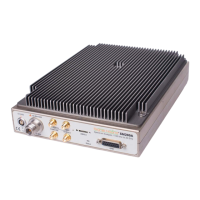1 Introduction
The purpose of this document is to
- Outline hardware requirements for 10GbE networks interfacing the Signal Hound SM200C
and SM435C networked devices.
- Provide recommendations for 10GbE networking components.
- Provide a brief overview of 10GbE networking for customers new to the interface.
10GbE Networking Overview
Signal Hound 10GbE devices operate over a single 10GbE link. Commands and data are sent
using a proprietary format over UDP at rates up to 6.4Gb/s. 10GbE is full duplex and can operate
over a number of physical channels. The two most common are copper and fiber cables. In
addition to cabling there are a number of interfaces and connector types used in 10GbE
networking, the most common is the SFP+ module. This connector form factor is what the reciever
uses and what we recommend customers use for their networks.
Figure 1: SFP+ 10GBASE-SR (fiber optic) module
Standard 10GbE network copper cables are terminated with two SFP+ connectors and can be
seen in the picture below. Copper cables are ideal for local applications where cable distances
don’t need to exceed more than a few meters. Copper cables are less complex than fiber
alternatives but will have data reliability issues at longer lengths.

